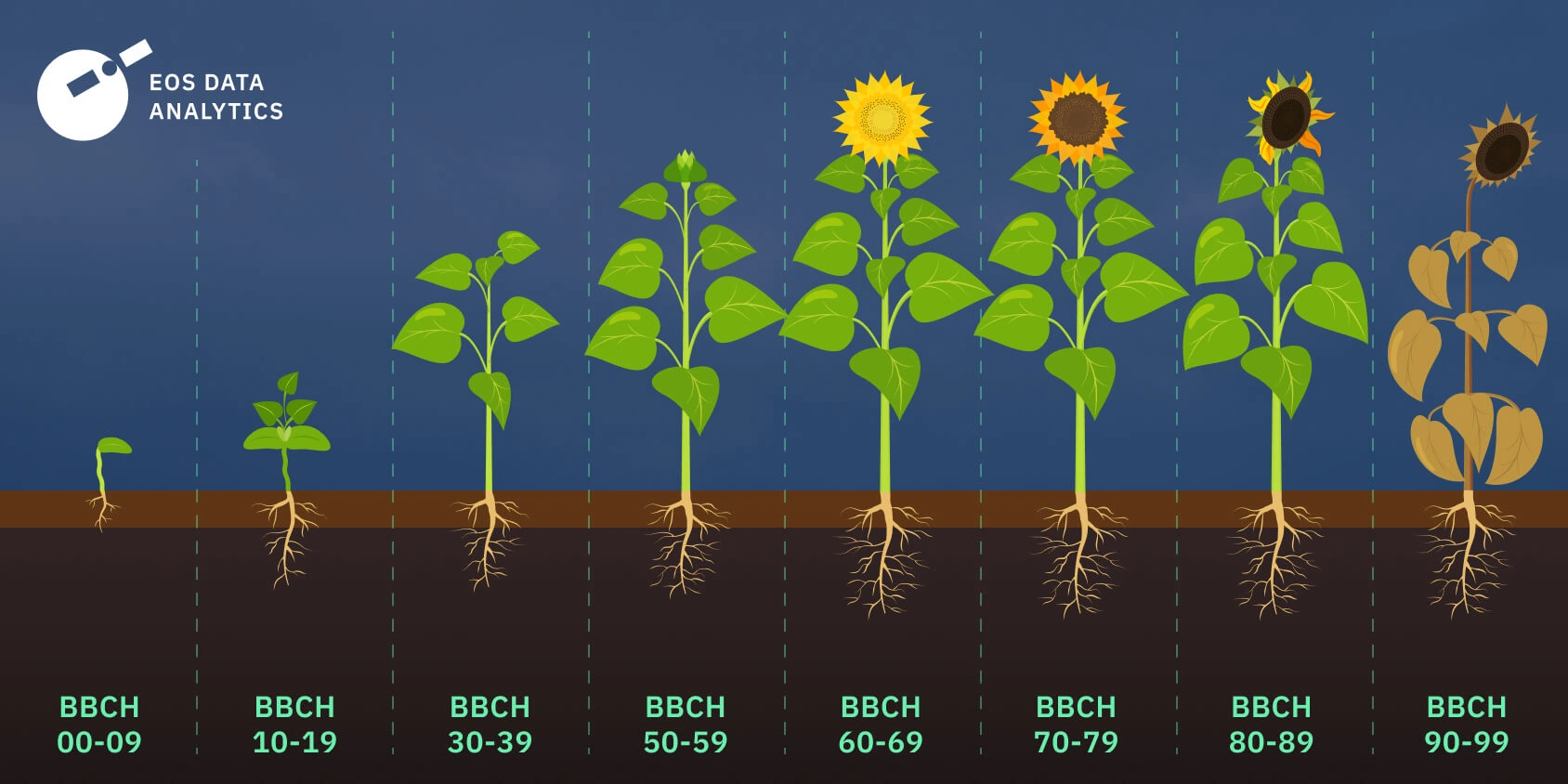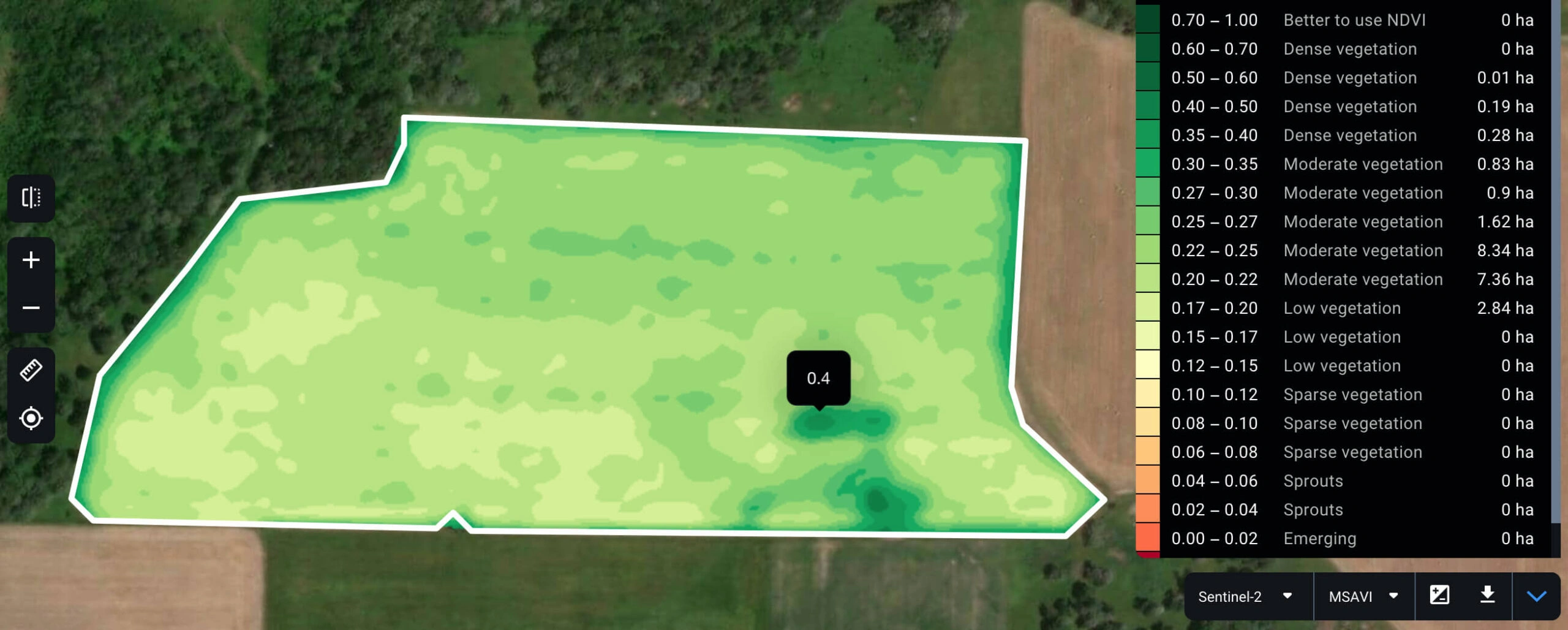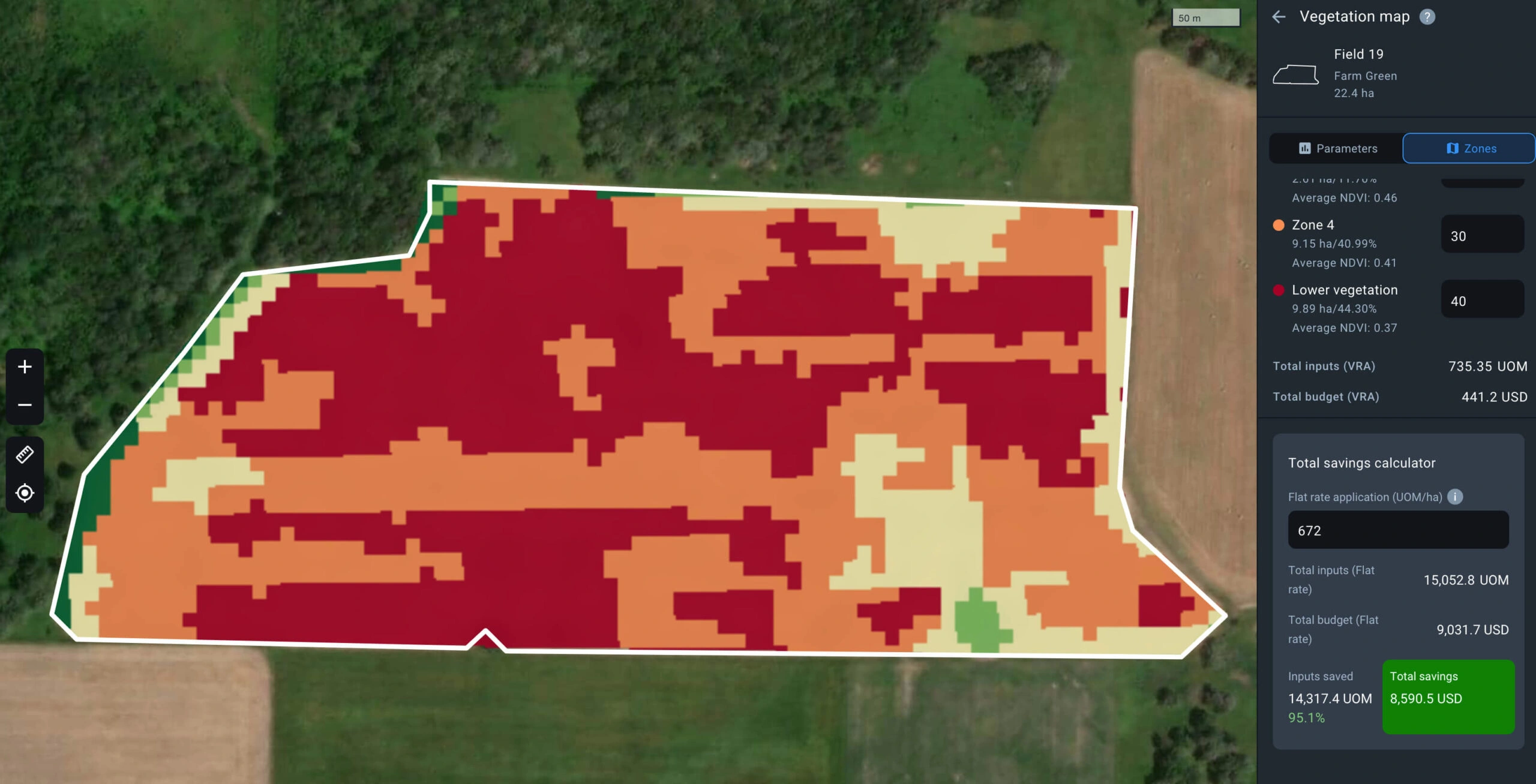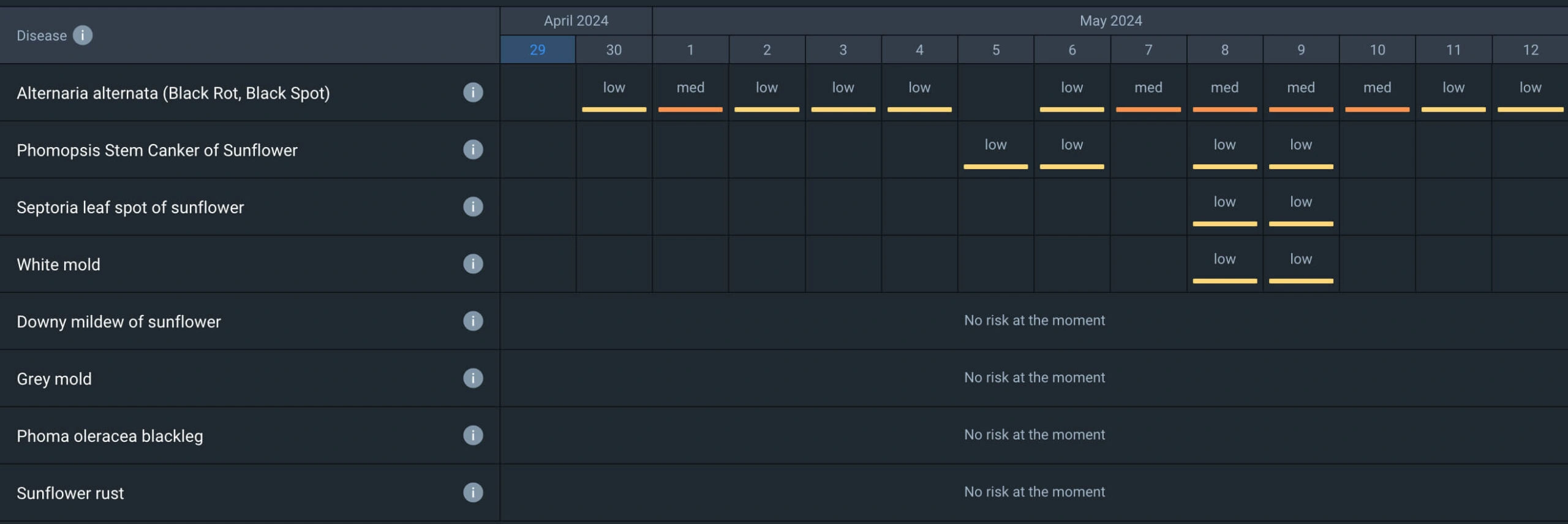
The recommendations provided in this article serve as general guidelines. Particular cultivation requirements may vary based on the unique conditions of each field and the selected hybrids.
Sunflower Growth Stages: All-Season Crop Management
Sunflower requirements for sunlight, nutrients, water, and other resources change from one growth stage to another. To cater to the varying crop demands, growers must familiarize themselves with the sunflower growth stages. For example, while plants only require a small amount of water for germination, insufficient water supply during flowering might reduce crop yield. However, it is possible to minimize watering and even desiccate plants before harvesting, when they are nearing the end of their ripening growth stage. We will now go into greater detail about these and other aspects of sunflower cultivation at various stages of growth.
BBCH-Scale For Sunflower Growth Stages
Only when a leaf fully unfurls is it counted as present according to the BBCH-scale. Sunflowers don’t pass the principal BBCH growth stages 2 and 4. The stem elongation stage in sunflowers may occur before secondary BBCH growth stage 19; if this happens, proceed to principal growth stage 3.
Stages of sunflower growth according to BBCH-scale
BBCH 00–09: Germination
During the sunflower seed germination stage, which lasts 2–10 days, the seed absorbs water and swells, causing its hard coat to soften and eventually crack. Water awakens the dormant embryo in the seed. At this stage, growing sunflower seed sends roots downward into the ground for water and nutrients and a shoot upward through the soil’s surface for sunlight.
Successful germination is the key factor in increasing plant number per unit area (first yield component). Sow exclusively pesticide-treated planting materials, as it is crucial to protect the seeds from pest insects. Also, place protective barriers against birds and small animals feeding on seeds. Once your seeds are protected, proper seed germination depends on the next three factors:
- Seed-to-soil contact. A firm seedbed lays the groundwork for robust sunflower growth. Use a moldboard or chisel plow to loosen the soil and promote water infiltration.
- Water. Even though moisture needs are low during this sunflower stage of growth, it is crucial to water the seeds evenly to initiate germination. An excess of water reduces the amount of oxygen that can reach the seeds, which slows down the germination process and ultimately influences the number of plants that emerge and how quickly they emerge.
- Soil temperature. Planting seeds in cool soil below 50°F (10°C) hinders emergence and increases the likelihood that pests and fungi will damage the plant. This could lead to irregular plant emergence and growth and eventual crop losses.
All the historical weather data you need to plan sowing activities is available in EOSDA Crop Monitoring. Pay special attention to data on precipitation, air temperature, evapotranspiration, global radiation, and relative humidity in your field. This data is useful not only for determining a suitable field and best sowing time for sunflowers but also for predicting future moisture requirements and planning agricultural operations throughout the season.

BBCH 10-19: Leaf Development
Changes occur in a seedling’s growth and development as it sees the light. The cotyledons become distinct, expand, and change color to green, while the process of stem growth slows down. Notably, during the sunflower leaf development stage, roots grow much faster than the aerial parts.
From BBCH 12 to 19, the sunflower secondary growth stage is determined by the number of true leaves measuring over 1.5 inches (4 cm). If the lower leaves have fallen off, you may tell what growth stage the sunflower is in by counting the scars left behind by fallen true leaves. A plant’s leaf production varies greatly from one type to another. The hybrid’s qualities, ambient temperature, and photoperiod (the daylight-to-darkness ratio) determine how long the sunflower seedling and leaf development stage will take.
Because the growth of young sunflowers is slower now than in later growth stages, it is crucial to give the seedlings the supportive nutrients, especially phosphorus (P) and nitrogen (N), and shield them from pests and weeds. During the first 30–40 days after sowing sunflowers, it is especially important to prevent the growth of common early-season weeds in sunflower fields such as kochia, horseweed, lambsquarter, and redroot pigweed.
During this stage of vegetative sunflower growth, scouting should be done regularly to prevent weeds from competing with the crop for resources. To improve scouting effectiveness, consult the MSAVI index in EOSDA Crop Monitoring. Instantly dispatch scouts to specific sections of the field with an unusually high index value (often due to weed growth).

BBCH 30-39: Stem Elongation
When the sunflower stem elongation stage starts, the stem has no internodes and is hence short. As the number and length of internodes increase, the plant becomes taller and thicker. At this sunflower’s growth stage, active cell division occurs, which, in addition to making stems taller, results in foliage growth. Sunlight, heat, and water all influence the growth rate. Now, nutrient feeding is becoming increasingly important.
Macronutrient Fertilization
Sunflowers can get by with relatively little fertilizer at this growth stage. Nitrogen (N) — the most critical macronutrient for the crop at BBCH 10–39 sunflower growth stages — should be applied now if it has not been applied earlier. To find out how much N fertilizer to use, conduct soil testing. More nitrogen supplied to the crop usually means more intense leaf and stalk growth. Despite this, the overall seed yield remains the same, which might be attributed to more severe lodging and disease susceptibility. On top of that, according to recent studies, the seed oil content decreases when nitrogen rates increase .
There’s barely any difference in output between a single N application around planting and a split application (half of the fertilizer at sowing and the other half somewhere between the BBCH 14–19 and 51–53 sunflower growing stages). However, the split application method provides farmers with a bit more control. Say you’re utilizing our NDVI index-based maps and notice low index values after initial fertilization, which could mean the crops haven’t got enough N and you should reapply it to boost vegetation growth.

Sunflowers need relatively little phosphorus (P) and potassium (K), and their well-developed roots efficiently scavenge any residual K and P. Hence, only the field soil analysis indicating nutrient deficiencies should dictate the application of these macronutrients.
Controlled Application Of Pesticides
Sunflowers at this growth stage are quite sensitive to herbicides. Drift and carryover from the previous crop are two potential causes of herbicide damage. You could also harm your sunflowers if you use the wrong kind of pesticide, apply too much, or spray it during high winds or just before a cold/wet spell. So, consider the weather before applying pesticides. With EOSDA Crop Monitoring, you can get a precise field-specific weather forecast to schedule herbicide applications for when they will be most safe and effective.

BBCH 50-59: Inflorescence Emergence
Flowers start to differentiate at this growth stage, and the number of seeds is determined. Beginning with the terminal bud forming a small floral head, which resembles a many-pointed star from above, this stage of sunflower development continues for 17–30 days and ends with an immature bud elongating over 0.8 inches (2 cm) above the adjacent leaf. When temperatures rise, the rate of flower differentiation quickens and its duration shortens. Root growth and leaf expansion are still ongoing.
Crop Management Guidance
During the sunflower bud stage, the plant uses the most resources. Hence, it’s critical to guarantee their availability in sufficient quantities and eliminate any obstacles to their consumption:
- At this growth stage, nutrient absorption is at its peak, so take care to apply nitrogen fertilizing beforehand, preferably during the BBCH growth stages 30–39.
- The success of the current stage of sunflower growth and development depends on the elimination of weeds in the previous phases.
- Keep an eye out for defoliating caterpillars, sunflower beetles, seed maggots, stem weevils, and other pests.
- When inspecting your sunflower fields, watch for rust, Verticillium wilt, downy mildew, and white mold. Foliar growth is the primary target of Verticillium wilt.
Monitoring Environmental Conditions
Water stress during the inflorescence emergence stage of sunflowers can impede the growth of leaves and reduce seed production. So, this is the exact stage to carefully monitor the soil moisture levels, particularly in the root zone. The NDMI index and root-level soil moisture data available in the EOSDA Crop Monitoring platform can serve as valuable resources for this purpose.

Sunflowers at the bud growth stage are also susceptible to flooding; plants inundated for three days or longer might not fully recover. Hot, sunny weather during flooding can increase plant mortality, while cool, overcast weather limits harm. If scouts can’t regularly check on flooded sunflower fields in far-off places, NDMI and soil moisture data in EOSDA Crop Monitoring (surface-level soil moisture is a good indicator for flooding) come in handy once more.

Sometimes, sunflower growers mistake lightning damage during the inflorescence growth stage for a disease. What sets this damage apart from disease-related damage is the abrupt mortality of all plants (except grasses) in the affected zone. This zone is typically circular, with a diameter of 50 to 100 feet (15 to 30 meters), and its growth stops two weeks after a lightning strike .
BBCH 60-69: Flowering
During the seven to ten days of flowering (BBCH 60–69), one of the crucial sunflower reproductive growth stages, the ray florets (petals) unfold and the stalk’s neck starts to slant. The disc growth continues until the petals completely unfold, and the outermost whorl of the disk florets discharges pollen.
The second yield component, the number of seeds set, is decided at this growth stage. Prolonged cloudy and rainy weather during the sunflower blooming stage can reduce pollinator activity or wash off pollen, leading to fewer seeds being set. On the other hand, when plants experience heat stress at this growth stage, it usually results in fewer seeds, reduced seed weight, and lower oil content. Thus, adequate water supply is crucial now.
The growth of white mold, Alternaria, and Phoma — which cause sunflowers to age prematurely — is encouraged by damp, cold weather during flowering. Phomopsis stem canker propagates in prolonged heat and high humidity. The weather is beyond your control, but you can detect sunflower diseases early through scouting. Instead of sending scouts on a blind hunt, employ index-based maps on our platform to remotely analyze sunflower health and conduct on-site checks only where anomalies are found.
Most diseases develop before the sunflower flowering stage and manifest themselves during it. Constantly monitoring crop health is crucial to reducing the occurrence of diseases and ensuring prompt treatment. EOSDA Crop Monitoring provides a powerful Disease risk feature that allows for a thorough analysis of different variables in the field and automatic assessment of the likelihood of particular disease development. You can use this function to keep an eye out for common sunflower diseases: white mold, downy mildew, rust, Phomopsis stem canker, and more. By adopting this approach, you can move from addressing the damage to early detection and proactively mitigating potential harm.

BBCH 70-79: Development Of Fruit
Once pollination is complete, the sunflower begins its most important, from the farmers’ perspective, process: the growth and development of seeds. Fertilized ovules in each floret turn into seeds. At this growth stage, the sunflower’s head starts to droop in order to shield the seeds. As the seeds develop, the sunflower head hardens. The petals wither and drop once they fulfill their function of luring pollinators.
Sunflowers need particular care at this growth stage to prevent damage from pests and diseases. Regularly scout for sunflower beetles and defoliating caterpillars. Also, watch for sunflower seed weevils, midges, and moths, since pathogens (for instance, rhizopus head rot) can enter plants through wounds caused by pest feeding.
BBCH 80-89: Ripening
At the start of the ripening stage, the sunflower petals have fallen off, while the back of the disc remains green. The back is gradually becoming pale yellow, but the bracts stay green. Seed moisture content decreases to 50%.
The BBCH 85 sunflower growth stage comes about once the back of the disc turns completely yellow. The bracts finally change color from green to yellow and brown at the BBCH 87 growth stage. This is when the sunflower reaches its physiological maturity. The seed moisture content drops to 30% or less. Eventually, at the BBCH 89 growth stage, the back of the head becomes marbled brown, and the stem begins to dry out. The seed moisture content falls to 15%.
Frost Damage
Once the discs’ backs start yellowing, frost is less likely to cause damage. After reaching the BBCH 83 growth stage, sunflowers might only suffer a slight injury from temperatures as low as 25°F (-4 °C). The temperature must remain below this threshold for at least six hours to damage the sunflower’s protective layer. Even though frost damage at this growth stage can diminish oil content, discolor some seeds, and lower yield and test weight, most seeds will still be fit for sale.
Desiccation And Harvesting
To hasten harvesting, some farmers opt to desiccate their crops. Wait until the sunflowers are at stages of physiological maturity before spraying a herbicide desiccant to avoid a reduction in seed yield and quality. Among the many advantages of early harvesting are reduced lodging, shatter, and pest and bird damage losses. Additionally, it can give farmers more leeway to disperse harvests, limiting the strain on resources like time, labor, and agricultural machinery.
EOSDA offers a custom harvest monitoring solution for agriculture cooperatives, large-scale sunflower producers, and landowners to:
- obtain regular data on the projected yield;
- get the harvested status of each sunflower field for a certain date;
- determine the best times to harvest each field;
- discover how many fields were harvested on a certain date.
This satellite-based data will be particularly helpful in verifying farmers’ reports without the need to physically inspect vast, scattered sunflower fields.
BBCH 90-99: Senescence
Before cell death, the sunflowers undergo senescence, the last stage of their development. The yield may decrease if heat stress or over-early desiccation initiates this sunflower stage, which involves crop degradation and remobilization, too soon. After harvesting sunflowers, the crop residue primarily consists of the stalks remaining in the field. Later, when the stalks dry out, agricultural machinery chops and distributes the residues across the field. The stalks disintegrate better when they are dry.
Despite many options for crop residue management, some farmers still burn sunflower production leftovers. Livestock grazing on leftover stalks or collecting residue for energy production are two more economically viable alternatives to burning.
About the author:
Vasyl Cherlinka is a Doctor of Biosciences specializing in pedology (soil science), with 30 years of experience in the field. He attended the engineering college in Ukraine and received his degree in agrochemistry, agronomy and soil science in the Chernivtsi National University. Since 2018, Dr. Cherlinka has been advising EOSDA on problems in soil science, agronomy, and agrochemistry.